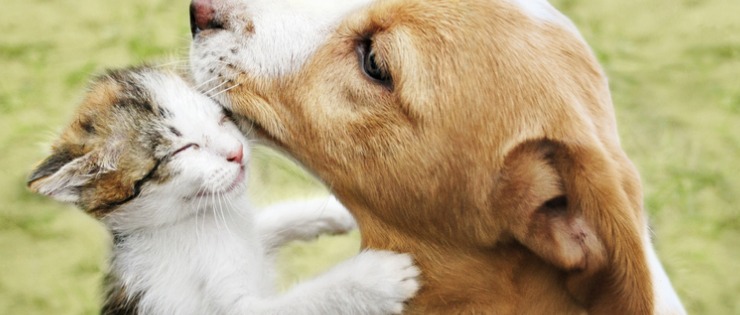
Introducing a kitten to a dog who is already established in your home can cause tension and stress for both animals. It’s unrealistic to expect your new kitten will be best of friends with your dog straight away but, with careful planning and slow introductions, you can have an amicable relationship between your furry friends.
We often think of cats and dogs as sworn enemies, but it doesn’t have to be the case. A cat and dog can be the best of friends once they know each other. With no direct competition, a dog and a cat can often have a better relationship than two cats.
How Long Does it Take For a Cat to Get Used to a Dog?
While every cat and dog relationship is different, expect them to take a few weeks to get used to each other and accept the changed situation. The introductions and success will depend on:
- The dog’s personality – if your dog has a tendency to be aggressive and territorial then consider if you really can expect them to get along, it may be difficult to make a successful introduction.
- Your dog’s history with cats – if your dog has lived with a cat before, it is less inclined to worry about the new arrival. If your dog already barks at cats and tries to chase them you’ll need to be much more careful with the introduction process.
- Previous training and temperament – if your dog is well-trained and obedient to your commands, it’s likely the introductions will go more smoothly than if you have little control.
It can be harder to introduce a new dog to an existing cat who has lived with you for some time. Cats are notorious for disliking change - they may feel threatened by the new arrival. A cat defending its territory can react by hissing and lashing out at the dog with their paw.
How Do I Get My Dog to Accept a Kitten?

Some dogs are very chilled out and accept changed situations easily, but don’t just assume your dog will accept your new kitten. It’s still worth taking the introductions slowly. You don’t want to stress either animal.
Allow your kitten to have a safe room away from your dog so he can relax without worrying the dog will appear at any moment. After a day or two, allow them to meet with the kitten secure in a carrier or by being held tight by an adult. Allow the kitten and dog to sniff each other. Give them both a treat so they associate the other pet with a tasty reward.
5 Steps For Introducing a Kitten to Your Dog
1. Keep Both Animals Seperate
When you bring your kitten home, don’t be in a rush to introduce him to your dog. Put your kitten in a safe room so it can get used to its surrounds before you make the situation any more stressful. Keep your kitten and dog in separate rooms for a few days.
Pat your kitten and dog and allow the other to smell the scent on your hands and clothes. Exchanging scents is important so both can get used to each other’s smell. You can even take some of the dog’s bedding and leave it with the new cat and vice versa so they become familiar with each other.
2. Introduce Them Through a Crate or Closed Door
Using a crate as a safe space for the kitten can be a good way to ease the kitten and dog into contact. After a week, or whenever you think they are both calm and ready to be introduced, place your kitten in its crate.

If your dog is likely to be excitable, try to wear her out with a long walk earlier in the day. Introducing them at night when they are both tired and relaxing in the lounge room may be more successful than in the morning. Bring the crate out to your dog. Keep the kitten’s cage away from your dog’s bed and bowls. Reward your dog for quiet behaviour.
Don’t let them make physical contact just yet. You want them to get used to being in the same room together. Keep the get-together brief. If they are together for too long, it becomes exhausting. Make each meeting a little longer than the last.
If you think you need to take things slower, you could introduce a dog and kitten from behind closed doors. Give them both their meals at the same time on either side of the door so they can smell each other while eating. After several weeks they will associate the other animal’s scent with their food. Eventually, you can place a leash on your dog and open the door so they can meet while eating.
3. Introduce Face to Face
When you’re confident your kitten and dog are used to each other from the crate and door introductions, consider allowing them to meet without the protection of the bars. Put your dog on his lead in case he tries to chase the kitten. Make sure the kitten has somewhere to escape to if threatened like another room or up a high shelf.
Continue with the introductions with the dog on a lead until you’re sure your dog won’t chase the kitten and then continue with supervised time together. Of course, it could be your kitten that is the aggressor. A kitten hissing at a dog is quite common. The dog may bark back at the kitten. Keep up the supervised meetings. A dog whining at a kitten could mean it either wants to go over and play or bite it! Be vigilant to ensure the kitten is safe.
4. Reward the Dog For Good Behaviour
If your dog is being well-behaved around the new cat, reward her with treats and attention. Like any type of dog training, positive reinforcement is the best strategy. Even if she is just ignoring the kitten, still reward the behaviour. You want your dog to associate pleasant thoughts and treats with the kitten.
5. Deal with Any Ongoing Tension
If you think your kitten isn’t completely comfortable with the dog’s presence, make sure he can access his food, water, litter box and bed without having to pass too close to the dog.
Give them both time apart regularly so they can rest knowing they are safe. If either pet needs some additional help with staying calm during introductions, see your vet.
Can you Train a Dog to be Good With Cats?

We can train dogs to do almost anything so training your dog to behave around cats is definitely possible. You can increase your chances with slow introductions and keeping your dog on the lead while they meet face to face. The dog will know you won’t tolerate her chasing the cat.
If your dog is impulsive and jumps up when it sees a toy it wants, chances are it won’t be great with a skittish kitten. A senior dog may not have much patience with an energetic kitten.
You want to be able to train your dog to stay away from the cat’s safe areas in the house like a bookshelf or a tall cat tree. You also want your dog to know to sniff around the cat’s litter box is off-limits. Not only should your cat feel safe using it, but you don’t want your dog contracting a parasite. While training is in progress, use baby gates to block the dog from the cat’s safe areas.
If your dog has plenty of energy, increase the time you spend walking or playing with them so they don’t want to chase the cat and play roughly. If you don’t have the time, look at placing her in a doggy daycare or hire a dog walker so she uses up some of her energy outside the house.
Seek Professional Help if Required
There’s no doubt introducing new pets into the house can be a stressful time – for you and them! The most important advice is to be prepared to take it slow. With some patience, your new kitten and dog should at least tolerate each other - they could even become best friends.
If you are having any problems or concerns about your dog’s temperament, contact an animal behaviourist or your vet for a recommendation. It can be much quicker and easier for both pets to get used to each other with professional training.